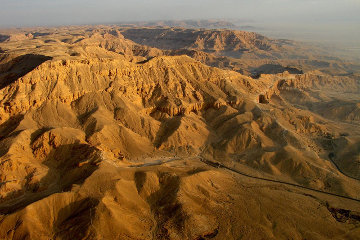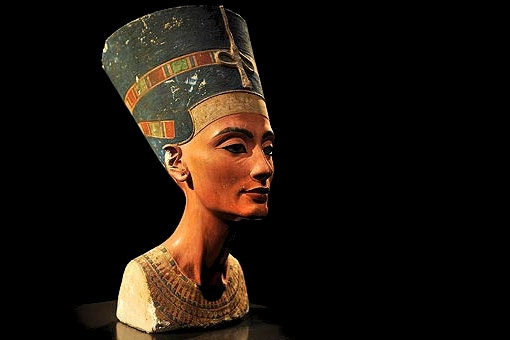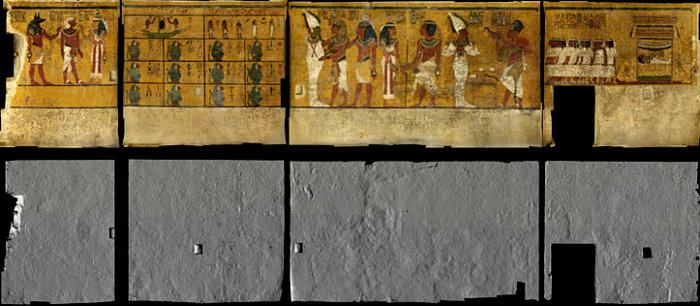Hidden doors?
The Valley of the Queens is not nearly as famous as the Valley of the Kings and it is not usually on the tourist trail. Everyone has heard of the Kings and wants to see the famous tomb of Tutankhamun; only history buffs have heard of the Valley of the Queens but all except the most dedicated find it too difficult to fit a visit to it into their crowded intinerary.

| |
| An aerial view (from a balloon) of the Valley of the Queens near Luxor. |
Even more discouraging for the casual visitor, of the 91 known tombs, most are small and hardly worth the trouble of a visit and the majority are permanently closed. The Tomb of Nefertari - QV66 - which is the largest and most decorated in the valley, was closed in 1950 because of concerns that the tourists were damaging the paintings. It remained closed until the Getty Conservation Institute paid for restoration and conservation work, which was completed in 1992. Even now, however, access to the tomb is severely limited and to my regret I have never been inside it.
The valley was not exclusive to the female sex. Rameses VIII is buried there as well as several sons of Rameses III, but on the whole the valley contains the tombs of all the queens and princesses of the 18th, 19th and 20th Dynasties. It may surprise people to know that the Valley of the Kings is also not exclusive, for there are several princesses buried in it - and one queen.
Hatshepsut may have claimed burial in the Valley of the Kings because she was a pharaoh in her own right. Following the death of her husband, Amenhotep II, Hatshepsut took over as regent for her infant son. Power is addictive, though, and when the son grew up, Hatshepsut showed no inclination to step aside for him. She dressed as a pharaoh, even down to the false beard worn on ceremonial occasions, and it is said that the only royal title she did not appropriate was that of "Great Royal Bull" - the reasons for this diffidence should be obvious!
Curiously, Hatshepsut has two tombs in the Valley of the King. It is believed that she started the first, KV42, while she was still nothing more than a queen. Once she became king, however, she either excavated or took over the tomb known as KV20.

| |
| The magnificent bust of Queen Nefertiti, now in Berlin. |
If Hatshepsut could claim a position in the Valley of the Kings in her own right, there is another queen that many Egyptologists feel ought to be buried in the Valley on the same basis, and that is Nefertiti, the supremely beautiful wife of the heretic pharaoh Akhenaton. We know that she was exiled from her husband's court in the final years of his reign (or exiled herself when he started to marry her daughters!) but some think that when Akhenaton died she took over as regent for his young son Tutankhamun.
The problem is that we don't know exactly when Nefertiti died. Some believed that she died in year 12 of Akhenaton's reign, five years before his own death. A badly weathered inscription found in a quarry near Amarna in 2012 proves that she was not only alive in year 16, but that she was still ruling jointly with her husband.
After Akhenaton's death there is evidence for a pharaoh by the name of Ankh-kheperu-re Nefer-neferu-aten. There are indications in the grammar of the inscriptions that this person was female, but her gender is confirmed by one inscription which gives her the title, "Effective for her husband" - that is, regent or co-ruler who acts in the place of her husband.
It is possible that this person is Meritaten, the daughter of Akhenaten and Nefertiti, who was married first to her father and then to Smenkare. Many believe this to be impossible, however, as it would require her to have become pharaoh, then to have stepped down to become royal wife to Smenkare. An additional complication is that some evidence suggests that Smenkare died before Akhenaton, his father-in-law, so that Meritaten was first wife and then pharaoh - but while it is conceivable that Tutankhamun's mother might be regent for him, it surely stretches credulity to breaking point to claim that his sister filled that role!
If there was a female pharaoh after Akhenaton, then in my opinion the most likely candidate is Nefertiti - and if that is the case, then it is surprising that she is not buried in the Valley of the Kings, particularly as she is not buried in the Valley of the Queens either!

| |
| Workmen from Factum Arte unwrap Tutankhamun's coffin in the replica tomb they constructed. |
In 2014 a Spanish company called Factum Arte was granted permission to scan the interior of Tutankhamun's tomb. Their intention was to build an exact reproduction of the tomb near Howard Carter's house on the west bank opposite Luxor to take the pressure off the real tomb, which suffers from the thousands of tourists who visit it each year. They also plan to erect replicas of the tombs of Nefertari and Seti I.
A digital scan uses a laser scanning device to record millions of points, which can then be linked to produce a 3-D model of the object. Once recorded, of course, such scans can be manipulated by the right software. Some years ago I wrote an article about a scientist who scanned cuneiform tablets and used software to give them different "coatings". A reflective chrome coating, for example, enabled him to read the badly damaged cuneiform on some of the tablets, others could be read by manipulating the direction from which the light came, and so on.

| |
| Dr Nicholas Reeves, an Englishman working at Arizona University. |
Anyone looking at the tomb of Tutankhamun finds his eye drawn to the paintings on the walls, which mask any irregularities in the plaster coating. Dr Nicholas Reeves, of the University of Arizona, got hold of the data recorded by Factum Arteand stripped away the paintings so that he was, in effect, just looking at the plaster itself. He immediately noticed some irregularities in the plaster than lined up to indicate that behind the plaster there may be a door.
In fact, there may be two doors in two of the walls. If so, it raises the intriguing possibility that the burial chamber of Tutankhamun is nothing more than a junction in a corridor of a larger tomb. Archaeologists have long wondered at the smallness of Tutankhamun's tomb and at its curious arrangement, but if it was a larger tomb converted, that would explain some of the anomalous features.

|
| The walls of Tutankhamun's tomb in reality above and the scanned version below. |
The question then arises, Who else might be buried with Tutankhamun? The most likely candidate is his missing mother (or step-mother). We know that Tutankhmun had strong family loyalties; he was buried with two premature foetuses, presumably from his young wife Ankhesenpaaton. He was also buried with a lock of hair from his grandmother, Queen Tiye. What more natural than that he should wish to be buried with his mother - and how convenient for the court officials who were faced with having to find a suitable tomb at short notice!
Dr Reeves has applied for permission to scan the interior of the tomb once again, this time with a radar scanner which will, he hopes, penetrate through the plaster and reveal the doorways behind. If he is lucky, it may even reveal the size of the rooms beyond the doorways - if there are such doorways.
Dr Reeves may think that locating these doorways will solve many problems of the history of the late 18th Dynasty, but in fact they will merely open a whole new can of worms. The two walls are decorated with the best frescoes in the tomb of Tutankhamun and it is - I sincerely hope - unthinkable that they should be destroyed simply in order to open up what may well turn out to be empty or unfinished rooms.
Of course, archaeology is all about destroying one thing in order to reveal another. An archaeologist uncovers a magnificent temple or palace and all the world throngs to see it. Newspaper articles are written about it, television programmes made about it, the archaeologist is lauded and praised for his remarkable discovery - but he is not happy. He cannot sleep at night, he chews his fingernails to the quick with anxiety, because all he wants to do is sweep away the inconvenient palace or temple and find what lies underneath it!
Fortunately there is an easy solution. The first step would be to drill a hole down from the surface into the room or rooms, then insert a camera and find out what is in the rooms. It might even be possible to insert a small remotely operated vehicle - an ROV - to explore round corners and down stairways if there are any. Then, if the discovery seems worth while, a staircase can be cut down to the new tomb, all without disturbing the priceless frescoes on Tutankhamun's walls.
If Dr Reeves is right and Queen Nefertiti is buried behind the plaster, it would be a sensational discovery that could very well put the finding of Tutankhamun's tomb into the shade. Not only would it be the second undisturbed royal burial to be discovered, but the wealth entombed with a powerful and elderly queen is likely to far out strip the few bits of gold and silver discovered with a young and ailing boy.
Keep your fingers crossed!
KV20 Some believe that KV20 was the first tomb in the Valley of the Kings and was originally constructed for Tutmose I. According to this theory Hatshepsut extended the tomb with a new burial chamber. Later, under Tutmose III, a new tomb was dug for Tutmose I and his body and funerary equipment was transferred there. The weakness of this theory is that pharaohs did not normally dig tombs for their predecessors - they were too busy creating and furbishing their own tombs! Return
Smenkare Smenkare's position in the Amarna court is highly contentious. It is possible that he was Akhenaton's nephew, others think that he is a younger brother. Some have hinted at a homosexual relationship between Smenkare and Akhenaton; whether that is so or not, the fact that he was given Akhenaton's daughter/wife as wife does point to an unpleasantly incestuous milieu to the court of Akhetaten. Return
© Kendall K. Down 2015





